Remains of the Basilica of Maxentius and Constantine in the Roman Forum in Rome. Built between 308-312 CE, the 35 metres high basilica was the largest building in the Forum (with an area of about 5,600 square meters), and the last Roman basilica built in the city
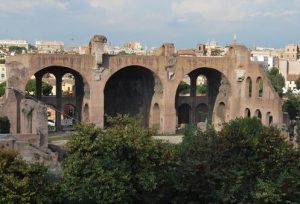
Fig. 1. What remains of the Basilica of Maxentius today.
Historical Significance
The turn of the third century was a defining moment in Roman history. Rome was in a recovery state, trying piece together an almost collapsed empire that had seen 50 years of invasions, civil war, plague, and economic depression. In AD 283 a fire on the Velia, a low ridge connecting the Esquiline and Palatine Hill that contained part of the Roman Forum, destroyed the Horrea Pipertataria warehouse along with many other buildings in the Roman Forum. As was common for the time, The Basilica of Maxentius was built on the site of the burnt down Horrea Pipertataria, between the Temple of Amor and Roma and the Temple of Romulus on Via Sacra. The construction of the basilica was seen to many as apart of the rebuilding and development of the Roman Forum as well as a symbol of a recovering nation.
The construction started in 308 AD by the emperor Maxentius and was later finished by Constantine after Constantine’s defeat of Maxentius in the Battle of the Milvian Bridge in 312 AD. Constantine’s defeat of Maxentius served as a turning point for building in the city of Rome. The empire began to see a decline in the construction of large vaulted public monuments, like the Basilica of Maxentius, which may serve as an answer for why the basilica had the largest concrete vaults to ever be constructed by the Romas. The reason for decline of large vaulted structures was in large part due to the change in economic and political climate. The state had formed somewhat of a monopoly over the production of brick, and were no longer benefitting from providing brick for large public projects like they had in the past. A change in the political leadership of Rome from Maxentius to Constantine also had an effect on the building in Rome. Constantine didn’t dedicate much time in Rome, thus leaving the type of structural skill that is exploited in the Basilica of Maxentius to go unused, and without further development. (Lancaster, 2005)
Traditionally basilicas were used as public market places and courthouses, acting as the roofed extension to the Forum. The Basilica of Maxentius followed this tradition serving as a meeting house, commercial area, and an administrative building. This building also housed the office of the ‘Perfect of the City’ – the highest imperial official in the late antiquity. Due to a prime location in the Forum, and functionality for the Roman government and public, it is not surprising that the building was designed in such a grand manner. (Aburdene & Williams, 2005; Seindal, 2013)
The Basilica of Maxentius also symbolizes a development of a traditional technique in combination with other structural elements, a characteristic unique to this building. In Ancient Rome basilicas often had flat ceilings supported by wooden beams and did not use arches. The Basilica of Maxentius takes the traditional format of a basilica and implements structural elements from public baths. Public Roman baths often-utilized arches, vaults, and domes. The Basilica of Maxentius utilizes large cross vaults over the central nave and barrel vaults spanning over 20 meters above the each of the side aisles. It was the introduction of this fusion of elements that made this building so structurally noteworthy for it’s time. Standing among the remains of the building, many may ask how the Romans were able to construct such a sizable building; and more importantly how the building was able once stand structurally sound.
Brief Discussion of Barrel and Cross Vaults
One thing continues to stand out in the discussion of why the Basilica of Maxentius is so remarkable is the buildings use of large unsupported barrel and cross vaults. The use of vaulting in major monuments showcases the ingenuity and development of the Roman use of concrete, which had developed over multiple centuries. Barrel vaulting was an expansive step up from one of Rome’s greatest inventions, the mason arch.
Barrel Vaults
A barrel vault is essentially an extruded or elongated arch. Therefore they share the same structural characteristics and the elements in which they rely on, and can be structurally analyzed in a similar way. They are dependent on four variables: the arc of embrasure, thickness of the arch, the free span, and the abutment thickness. The arc of embrasure is the angle created by two lines extended from the center point of the defining arch to the springing point of each side of the arch. This angle can range from 0 to 180 degrees, 180 degrees being a full semicircular arch. The shallower the arch, and thus the arc of embrasure, the greater the horizontal thrust on the abutment. The more rounded the arch, and arc of embrasure, the smaller the horizontal thrust. The arc of embrasure served as an easily observed rule of them for Romans when designing and choosing dimensions for arches or vaults.
The thickness of the arch and the free span are often referred to as a ratio and another rule of thumb. The ratio of thickness to the free span, which Lancaster cites from C. O’ Connor, should be 1:10 with a max of 1:20. Lancaster also cites C. O’Connor for noting that when the arc of embrasure is less than 180 degrees – meaning the arch was not perfectly semicircular- the safer it is to build a thinner arch. Therefore, it is important to note that all three of these factors are interrelated – arc of embrasure, thickness of the arch, and the free span. The last important fact is the abutment thickness. This correlates with the fact that the barrel vault must have a good capacity vs. demand ratio, with an abutment strong enough to support its outward thrust (Lancaster, 2005).
Imperial Roman vaults were supported by walls, columns, and eventually buttressing elements. While most think of typical buttressing in the form of arches, the Romans developed a sophisticated technique that used vaults to buttress other neighboring vaults. Often times the span of a large central vault was buttressed by smaller barrel vault rooms running perpendicular to it. This is seen in the Basilica of Maxentius where the lower level barrel vaults are used to buttress the above cross vaults over the central nave. This same technique can also be seen in the Nymphaeum Suite in the Domus of Aurea.
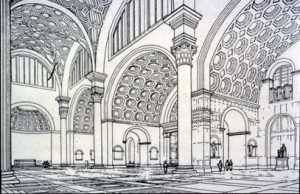
Fig. 2. Barrel vaults running perpendicular to the cross vaults above (Source: google images)
Cross Vaults
Cross vaults are arguably more efficient than barrel vaults. Cross vaults can view as the combination of two perpendicular barrel vaults, hence the name cross vault. It is important to note that at times cross vaults are termed groin vaults as well. Their load concentration is also a bit different from barrel vaults. While barrel vaults distribute their load over the span of an entire wall, requiring quite a bit of strong supporting wall, cross vaults direct both their vertical and horizontal thrusts to their corner supports. This system is much more complex than that of the barrel vault and because of this there is controversy amongst engineers regarding the understanding of the workings of cross vaults. A structural analysis of a cross vault, done by researcher Delanie, will be discussed later in this paper. (Lancaster, 2005)
Cross vaults produce horizontal thrusts in two directions on their abutments to give a resulting diagonal line of thrust. Usually this resulting thrust is greater than that of a barrel vault, due to the fact that barrel vaults distribute their trust over a wall, while cross vaults centralize their thrust to a point. It is because of the larger thrust of the cross vault at these corner points that the corners are thickened to provide a stronger support. One major benefit to having the centralized thrust of the cross vault was that cross vaults did not require such a thick supporting wall, which results in a small wall thickness to free span ratio. Lancaster states that the free span along the diagonal tends to be more conservative, 1:8 rather than the 1:10 of a barrel vault. Although the load is distributed differently between a cross and barrel vault, they can both utilize opposing horizontal thrusts from neighboring vaults as support for their own thrust. Another benefit of the cross vault, which is more aesthetically than structurally appealing, is that it allowed more natural light into a building, which was often important in Roman structural design. When analyzing the use of barrel and cross vaults, it is easily shown how cross vaults produced more benefits than barrel vaults which explains why cross vaults are one of the more widely used elements of Roman structural design. (Lancaster, 2005)
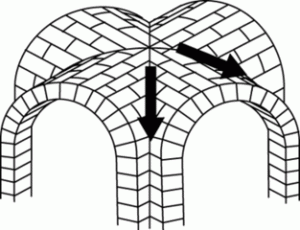
Picture of a cross or groin vault which shows the forces distributing towards the corners of the vault. (Source: Google Images)
Construction Technique
Due to the size and structure of The Basilica of Maxentius, the construction required organization and skilled technique. In a paper on the organization and construction process of The Basilica of Maxentius, Carla Maria Amici describes the innovative construction techniques used by the Romans.
Supporting Walls
A major concern when constructing a building on such a large scale, and with varying load distributions, is settling and cracks. The Romans combated this by utilizing the technique of non-toothed construction joints. Different sections of wall, each experiencing different stresses and loading conditions, were built separately. Due to these differences, each section of wall would settle at different rates. By leaving the joints non-toothed, they could act as hinges – able to rotate and slide, but remaining substantially rigid. This same system is used on the upper part of the walls where the barrel vaults are attached to a column supporting the cross vaults over the central nave (Amici). This shows how Romans planned for ‘controlled’ cracks by having non-tooth construction joints at pre-determined points. Rather than worrying about how loads would differ after the settling, they broke the structure into sections and relied on the strength of the walls to continue to support the weight at these ‘planned cracking points’. This innovative technique is an important point to study when trying to understand how they constructed strong supporting walls in connection with huge barrel and cross vaults.
Barrel Vault Construction
The construction of the cross and barrel vaults proved to be a complex process as well. After the construction of the supporting walls, the barrel vaults were constructed. One technique that the Romans used on vaults was lattice ribbing. Lattice ribbing requires a specific pattern of bricks, which improves load distribution and also helps to stiffen the vaults (figure 3). Each vault had two layers of ribbing, and allowed a strong shell to harden over the centering, the wooden support provided to help support the vault during construction. The shell then provided a strong support when the spandrels were later filled; entablature placed, and several layers of concrete used to finish each barrel vault. The barrel vaults also had octagonal coffers, which helped to reduce the overall weight of the vault and thus proportionally reducing the horizontal thrust. The coffers also allowed the vaults to maintain minimum thickness, which was always preferred by Roman constructors due to conservation of materials. (Alburene & Williams, 2005; Amici, 2011)
Each vault was constructed at the same time, which was important due to the fact that as they were built up, their interacting thrusts increased, therefore requiring their construction to be symmetric. Placement of the floor mortar over the terrace was placed later to ensure maximum cohesion with the system of barrel vaults and provide stable support at the springing of the barrel vaults. Although there is no existing evidence of this, many also believe that amphoras (figure 4) were used in in the construction of the barrel vaults, which would help to reduce overall load (Lancaster, 2005).
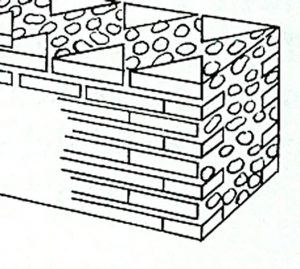
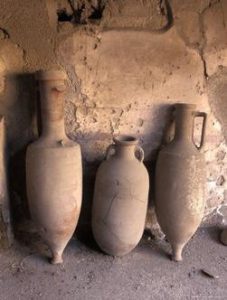
[LEFT]: Fig. 3. Example of lattice ribbing
[RIGHT]: Fig. 4. Picture of the type of amphoras used in the construction of the vaults in the basilica
Cross Vault Construction
After the barrel vaults were constructed, marble was applied to the face of wall, and the column to support the cross vault was raised into position (figure 5). The entablature, or top of the column, was inserted into place and the supporting wall behind completed (Amici, 2011). These structures acted as abutments for the cross vault over the central nave. The wall below the entablature, which supported some of the thrust of the cross vault, was built separately and also had a non-toothed construction joint. Abutments for the central cross vault, in the form of buttressing arches, were also built to help support the outward thrust. As discussed before, the perpendicular barrel vaults also provided further support for the thrust of the cross vault. The Romans also utilized lighter aggregates and materials on the upper part of the vaults to further reduce weight and outward thrust. Lastly, the roof above the vaults was triangular, which helped to distribute the weight to the corners of the cross vaults below. (Lancaster, 2005)

Picture of what remains of the supporting column for one of the corners of the cross vault.
Use of Terracotta Tubes
For the importance of measurement and placement, the Romans used terracotta tubes. Each tube was 2/3 of a Roman Foot in diameter and often positioned vertically over the centering against the exterior of the piers. The terracotta tubes were used to measure the thickness of concrete and as a plumb line to determine positing. Using the terracotta tubes as a plumb line played a crucial role in construction. Careful measurements were often required when placing structures like the buttressing arches, which were placed on top of the barrel vaults, and used to support the central cross vaults. The buttressing arches had a width that was smaller than the wall on which they stood, so the precision in their placement was extremely important. (Amici, 2011)
The terracotta tubes were also used in the construction of the barrel vaults. Rectangular hoes were placed in the walls to provide support for the main beams of centering. A horizontal cavity, parallel to the ground, was left for the terracotta tubes at the spring line of each barrel vault after the centering was taken off. The points in which the terracotta tube and the rectangular holes intersected served as reference points that could quickly be referred to. The availability to these reference points were crucial in the construction of many elements of the basilica, such as the four supporting buttressing arches for the cross vaults over the central nave. Each supporting buttress was done without interruption, similar to the barrel vaults over the aisles, so it was important that they were placed correctly and had correct facing. The use of terracotta tubes for precise measurements shows how organized and meticulous the Roman’s were when constructing not only the basilica, but other buildings as well. This same technique is used at the Basilica of the Trajan Market and the Servian Bath on the Palatine.

Fig. 6. Holes left in the barrel vaults of Trajans Market which show that the terracotta tubes were also utilized in their construction. (Source: Amici 2011)
The organized and planned construction of the Basilica of Maxentius shows the complex understanding that the Romans had of structural engineering – tensile stresses, lateral thrust, and load distribution. This took many years to develop and the basilica is a showcase of technique and concrete mastery.
Modern Condition of the Basilica
The Basilica of Maxentius serves as a good site for many engineers to perform structural research. This is due to the large size of the vaults, which were the largest known to have been constructed, as well as the basilicas partial collapse. (Delanie, 2012) Since it is believed that the structure failed because of an earthquake, the partial collapse of the building serves as an interest for modern engineers to study the seismic behavior of structures with large vaults. Also, studying the deformations of the structural elements is important for the preservation of what remains of the basilica today. (Alburene & Williams, 2011). The fact that only a portion of the building remains and little is known about small variations in geometry that may have occurred, as well as the cause of the collapse, coming to conclusions about how structurally sound the building was before it’s collapse must be deduced from analysis of the buildings remains.
Much research has begun by surveying specific features of the building. There are seven main features of interest: floor plan, transverse profiles of barrel vaults from the north nave, plump lines of load bearing walls, remains of the springing of the cross vaults, north façade, damage on top west end of the north nave, and the geometry of the coffering of the barrel vaults (Delanie, 2012). Studying each of these features provides clues for researchers on how the building once stood structurally, how it still stands today, and what needs to be done in order to keep it standing in the future.
Research was done by Alejandara Alburene and Martin Williams to further analyze the modern condition of the basilica. What remains of the basilica is only about one third of the original structure: one of the three original naves, with the rest of the vaulting and supporting walls of the building collapsed and destroyed. The collapse of the building also caused damage to certain parts of the building. For example, significant damage to the Northwestern barrel vault occurred during the collapse when a large portion of the buttressing fell off, which caused it to become one of the biggest threats to the overall stability of the remains. (Alburene & Williams, 2011)
Deformations
Deformations in the remains also bring rise to many questions about small errors in the geometry of the building that may have had a large effect on the structure at one time and may still cause danger to what remains of the building today. While researchers have different beliefs on what caused these deformations, the most popular conclusion is that it is due to either errors in the construction process and/or the mechanical behavior.
The first step when analyzing the deformations is the structurally assess what remains of the building and compare that to ideal geometry. When materials of low tensile strength, such as concrete, have compressive loads the resulting thrust can cause joints to open and divide the structure into blocks (Delanie, 2011; Alburene & Williams, 2005). Deformations can occur when these blocks rotate, but remain essentially ridged. That structural theory allows researchers to analyze vaults and barrels using a variety of techniques. Delanie uses the four-hinge sway mechanism to assess the current condition of the western barrel vault. The result of her analysis showed that for the given profile (western barrel vault) the minimum thrust calculated stays inside the section of the structure (figure 8), one of the key factors structural engineers use when assessing stability. While the geometric analysis of the barrel vault shows stability, the safety margin is very small. In fact that western barrel vault currently has steel ties assuring stability because of this. The finding of her analysis applies not only to this vault, but similar deformations in the other standing barrel vaults are noted in her research.
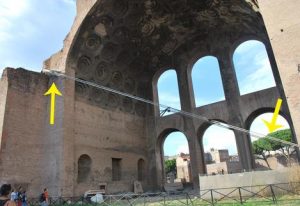
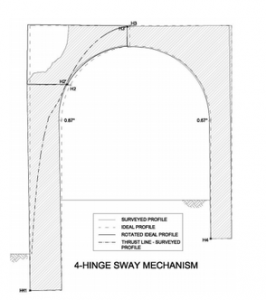
[LEFT]: Fig. 7. Steel ties on the Western barrel vault which ensure it structural stability.
[RIGHT]: Fig. 8. 4-hinge analysis of the Western barrel vault (Source: Delanie, 2005)
Another vault of interest is the east barrel vault next to the north nave. It is clear that the profile of this vault is not perfectly semicircular (as seen in figure 9). Delanie cites a study in her research that hypothesizes the deformation occurred during the construction process. The study, previously cited and done by Lancaster, explains that the deformation may be due to deformations in the centering, which was made of timber and somewhat vulnerable to structural flexibility, as a response to the self weight as the vaults were filled with Roman concrete.
As weight was built on top of the centering, from the outside of the arch inward, the wooden structure began to deform. The weight then pushed the sides of the centering inward, causing the crown of the arch upward increasing the length. One technique that was used to combat such deformations was to simply weigh the crown down by attaching rocks to keep it from rising. (Lancaster, 2005)
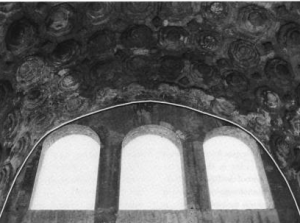
Fig. 9. Eastern vault that shows some deformation (Source: Lancaster, 2005)
Alburene and Williams challenge this theory and provide an alternative explanation for the deformations of the vaults.“Should centering deform under gravity loads, the timbers forming at the circular top chord of the truss would be under compression, thus experiencing…a reduction in length, but never yielding a longer chord profile”
(Alburene and Williams, 2011) What Alburene and Williams state here is that the current circumference of the deformed arch has a length larger than the circumference of a semicircle with a diameter equal to the distance between the abutment walls. Had the centering been deformed due to gravitational forces, this would alter a measurement in length or distance between the spring line and the vertex of the arch, but never change the measurement of the actual circumference. Therefore, Alburene and Williams deduce that it may have been caused due to modifications made during construction.
Alburene and Williams analyze the same eastern vault. The first important piece that they discuss is the evidence that the Northern wall was built before the vaults. “Conclusive evidence is given…the brick arches around the windows in the northern wall are partly hidden on the inside by the vaults. An error must have been made…the window in the top row either too high up or too far apart from each other. As a result, the geometry of the vault had to be altered…” (Alburene and Williams, 2005). They state that the hidden window implies that the top row was misplaced during construction, causing the geometry of the vault profile to be altered in order to keep the window from being blocke. This would cause the geometry of the entire vault to change from the ideal semicircle and thus producing the deformation we see today. Further analysis done by Alburene and Williams suggests that the vault construction started without centering due to the fact that centering for such a large vault would be costly and the Romans lacked the technology, again disproving the misshaped centering theory.
The importance of understanding this deformation is certainly important. The small misshape seen in the eastern vault has a large impact on the rest of the structure. Compared to the ideal geometry of a semicircular profile, the actual deformation an outward thrust ten percent higher than that of the ideal (Alburne). This finding makes sense when looking at the deformation simplistically. The deformation causes some of the fundamental aspects of the arch and barrel shape, that were discussed previously, to change. The arc of embrasure is altered, making the arch shallower and increasing the horizontal thrust as Alburene and Williams discovered. As stated before, Delanie’s analysis states a small safety margin therefore making the increased thrust a danger to the remaining structure.
The deformation of the barrel vaults are not the only deformation seen in the current condition of the Basilica. Though the ground on which the Basilica of Maxentius was leveled before construction, it has since increased in slope. The highest point of the building is the Northeast corner, and the lowest is the Southwest. The difference in height between the two is close to 8m, which is quite a substantial amount. Yet, the Western external wall is thicker than that of the East by .5 meters, which shows that the Romans might have been aware of the difference in height and foresaw problems it would produce. Unfortunately increased thickness is not enough as modern surveying shows that the two walls connected to the Northwest vault are learning towards the west by differing amounts. This also contributes to the instability of the modern day remains and could be very problematic in the future.
Static Cross Vault Analysis
As mentioned before, the structural workings of cross vaults remain somewhat of a mystery to engineers. Delanie makes an attempt to expand her research to further understand how the cross vaults covering the central nave ‘worked’, something that many engineers and architects still don’t understand about the large concrete cross vaults in the Basilica of Maxentius, as well as cross vaults in other Roman buildings. This is especially difficult to do due to the fact that many buildings, like the basilica, have little to no remains of the vaults that once existed. Delanie uses an analysis of the floor plan, footprint of barrel vaults, and remaining fragments of the cross vault to make a 3 dimensional reconstruction. Her analysis of the floor plan and barrel vaults suggest that the cross vaults had a rectangular plan – larger longitudinally – which had a direct impact on the structural behavior of the vaults. Due to the difference in dimension, the vaults are believed to work in the direction of the shorter span (in the transverse direction). This would have a positive effect, and make more sense structurally, as the basilica had more buttressing in the transverse direction rather than the longitudinal. (Delanie, 2012)
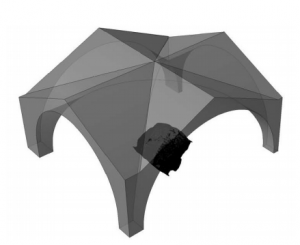
Related Post
A shocking documentary proves that mermaids do exist
SHOCKING Revelation: Thuya, Mother of Queen Tiye, Was the Grandmother of Akhenaten and Tutankhamun—What Ancient Egyptian Secrets Did She Leave Behind?
Breaking News: Astonishing Discoveries at Karahan Tepe Confirm an Extraterrestrial Civilization is Hiding on Earth, and NO ONE Knows!
Breaking News: Researchers FINALLY Discover U.S. Navy Flight 19 After 75 Years Lost in the Bermuda Triangle!
NASA’s Secret Investigation: Uncovering the Astonishing Mystery of the UFO Crash on the Mountain!
Explosive UFO Docs LEAKED: Startling Proof That Aliens Ruled Ancient Egypt!